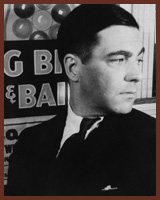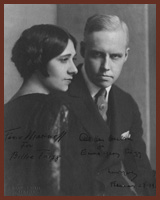

(left) Hunter T. Stagg, ca. 1925. Courtesy of Special Collections and Archives, James Branch Cabell Library, Virginia Commonwealth University, Richmond, Virginia.
(right) Cal Van Vechten and his wife Fania Marinoff, ca. 1925. Courtesy of Special Collections and Archives, James Branch Cabell Library, Virginia Commonwealth University, Richmond, Virginia
By 1926 Bolling was beginning to carve figures and exhibit them locally. Three Richmond men—Hunter T. Stagg, Berkeley Williams, and William Young—brought his work to the attention of Carl Van Vechten, a New York writer and photographer deeply involved in the New Negro movement in Harlem.
A native of Richmond, Hunter T. Stagg (1895-1960) co-founded The Reviewer, a literary magazine published from 1921 to 1925. He wrote book reviews and reveled in close associations with writers. He was also an enthusiastic supporter of African American artists and writers. In 1926 Stagg hosted an interracial party to honor poet Langston Hughes who was visiting Virginia Union University. He later worked as literary editor for the Richmond Times-Dispatch and the Richmond News Leader.
A journalist and writer, Carl Van Vechten (1880-1964) supported new art and literature and became deeply involved in the Harlem Renaissance. Friends with the leading African American writers and poets, such as Langston Hughes and James Weldon Johnson, Van Vechten also collected works by black artists, including Bolling, whom he promoted among his social circle. He showed Bolling's work to friends, including modernist sculptor Gaston Lachaise, and sold several pieces to New York collectors. Van Vechten's novel about nightlife in Harlem, Nigger Heaven, was published in 1926 amid a storm of controversy. He later became an accomplished photographer.